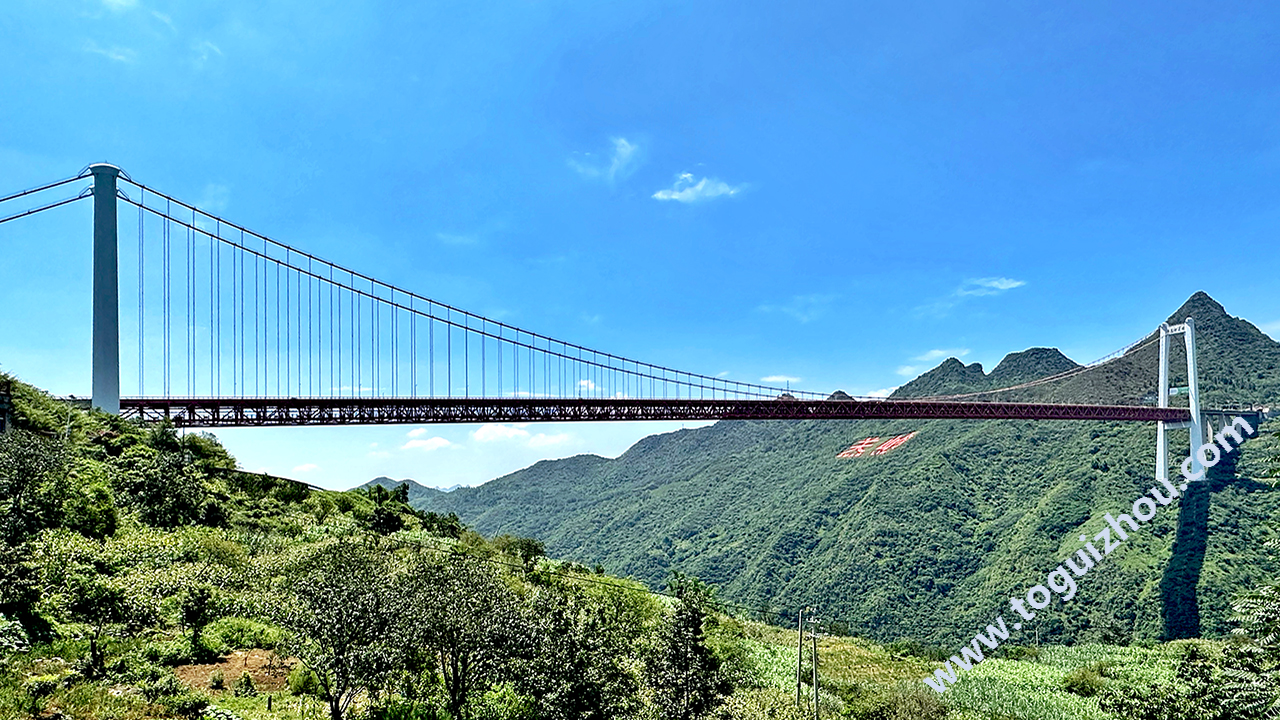With a height of 1,214 feet (370 mtrs) from deck to water, the Balinghe River bridge is the 15th highest bridge in China. Located near the town of Guanling about a third of the way along the 300 mile (483 km) G60 Hukun Guiyang to Kunming Highway in China's mountainous Guizhou Province, Balinghe is one of two super high suspension bridges along the 4-lane route.
Of the world's 300 or so highest bridges, Balinghe is unique for having the 10th longest span length with a distance between towers of 1088 meters / 3,570 feet - nearly as long as the Golden Gate bridge! The gap is so great the bridge appears to be floating among the clouds as it connects two mountain ranges. Balinghe is one of a dozen high Chinese suspension bridges with extremely long spans. Some of the others are Siduhe, Aizhai, Jinshajiang Bridge Jin'an, Dahe, Qingshuihe, Chishuihe Bridge Hongjun, Kaizhouhu, Daduhe Bridge Xingkang and Beipanjiang Huajiang bridges.
Prior to these spans, the longest bridge of any notable height was the New River Gorge bridge in West Virginia with an arch span of 518 meters / 1,700 feet. In 2012 the world's longest span high level bridge record went to China's Aizhai Bridge with a span of 1,176 meters before being surpassed in 2020 by the 1,386 meter span Jin'an Bridge.
The design of Balinghe is similar to some of China’s other long span suspension bridges that cross the lower end of the Yangtze but with an extremely deep 10 meter deep stiffening truss below the road deck which harks back to the classic, post-Tacoma U.S. suspension bridges of the 1950s like the Mackinac bridge in Michigan. This design was put to the test in May of 2016 when a hurricane hit the bridge with speeds of 34.4 meters per second, exceeding the design wind speed of 25.9 m/s, causing ruptures of the optical cable and pipeline.
While a suspension bridge might seem to be a no-brainer for such a long, high crossing, Chinese engineers did design a concrete beam viaduct and several multi-span cable stayed bridges. With a central tower rising nearly 457 meters / 1,500 feet, any one of the cable stayed schemes would have surpassed France’s Millau bridge as the world’s tallest. With so much concrete required for so many tall piers, there simply was not enough natural sand found at or near the bridge site and man-made sand is not suitable for concrete mixing. If natural sand had been transported from a far city, the cost of the project would have sky rocketed.
Balinghe bridge is located in a hot spot of high Chinese bridges and is less than 161 kms / 100 miles from many others in the region. Also be sure to visit nearby Huangguoshu waterfalls, one of the largest in China with a drop of 74 meters / 243 feet. Of all of China’s provinces, Guizhou (pronounced Gooey-Joe) has the greatest number of high bridges with many more to come in the next decade.
If you are wondering why Balinghe bridge has the unusual span length of 1088 meters, it relates to the luck the Chinese associate with the number 8 which sounds like the Mandarin word for “prosperity”. It was no coincidence that the Beijing Olympics began at 8:08 pm on the eighth day of the eighth month of 2008. Several other high suspension bridges also have metric span lengths that end with the number 8 including the Beipanjiang Guanxing Bridge with a span of 388 meters and the Xixi suspension bridge with a span of 338 meters. There is, however, no superstition related to the number 13, so watch out or you may find yourself on the 13th floor of a Chinese hotel!



